America is full of vacation lodges . . . on wheels!
They are known as motor homes — literally kitchens, living rooms, and beds on the move across America. Some people call them “recreational vehicles,” or “RVs.” Still others, thinking back to more of a golden age of highway travel before crowded, high-speed highways criss-crossed the nation, called house trailers pulled by small trucks or large cars “land yachts.”
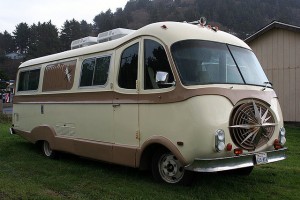
This is a fairly small, unusual, and comfortable-looking motor home. (Slideshow Bruce, Flickr Creative Commons)
There are more than 1.5 million rolling dwellings in the United States. Rolling, as opposed to those whose owners plopped their mobile homes down in what are called “trailer parks,” took off the wheels, put a little fence around them, planted some pansies, nailed on a mailbox, and ended the vehicles’ days on the road forever.
There’s a clever nickname for trailer parks, too: “static caravans” — an oxymoron if I ever heard one.
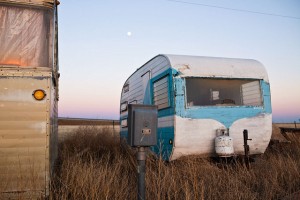
Things don’t look so prosperous, in this row at least, at a trailer park on the edge of the prairie. (Charles Henry, Flickr Creative Commons)
Some trailer parks — I’m thinking about dingy ones way back in the shadows of glamorous Las Vegas casinos — are sorry-looking, part of what Carol and I call “Disappearing America.” Their occupants, who are often low-income hourly workers at places such as those casinos, are sometimes disparaged as “trailer trash.” James Carville, a sharp-tongued adviser to President Bill Clinton, for instance, once said, “Drag $100 bills through trailer parks, there’s no telling what you’ll find.”
In our many travels, Carol and I have encountered a few cranky, unkempt trailer-dwellers (and their Dobermans and pit bulls), but many more sweet folks who enjoy a quiet life and simple pleasures. We’ve also found amazingly refined communities, especially in retiree-filled places like Florida. In fact, When Carol and I were there not too long ago, we learned that there are several entire COUNTIES in the middle of the state that have more people living in mobile-home parks than live in regular houses or apartment buildings.
Some trailer homes are almost as fancy, varied, and enormous as permanent “McMansions” down the road. These can sell for a quarter of a million dollars or more. Luxurious, split-level models even feature complete playrooms and laundry facilities, just like you’d have in your basement.
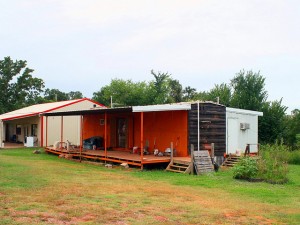
Talk about creative. A combination house trailer and railroad car made into a double-wide! (Chuck “Caveman” Coker, Flickr Creative Commons)
That’s thanks in part to the advent of “double-wides.” These are two units — each with one long façade open to the elements — towed to their final berth separately, then joined to make a single home as wide as a good-sized cottage. That trip to their concrete slab was their only moment on the road.
And speaking of the road, let’s get back on it.
Since a motor home vacation is often cheaper than a trip requiring stays at hotels and resorts, one might think the RV industry is thriving, despite the longest and deepest recession since the 1930s.
But not so. About 62,000 new motor homes rolled out of dealerships in 2004, but just one-third that many were sold last year. Orders are way up this year, however, as consumer credit loosens somewhat. Through October, RV manufacturers shipped almost 211,000 units to dealers, an increase of almost 53 percent over last year.
Out West, especially, you see thousands of motor homes, now that so-called “snowbirds” have moved south for the winter. There, you see so many RVs around national parks and tourist attractions that you sometimes wonder whether there’s anyone left back home.
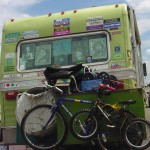
Space is at a premium — for everything but posters — in this hippiemobile. (stopnlook, Flickr Creative Commons)
RV owners have clubs, magazines, a national association — even conventions, twice a year! There’s one for widows and widowers, a group that loves to go to country-music festivals, another for motor-home owners who like to skydive, and, I would bet, a club for nudists on the go.
Possibly excluding the nudists, these vagabonds are warmly welcomed in most places, because they are often retired couples who have money to spend, teachers with an entire summer available for travel, or well-behaved families on vacation. Many motor-home owners have driven to all but one U.S. state — the exception being Hawaii, way out in the Pacific Ocean. Even there, there are plenty of recreational vehicles for rent, though the islands’ narrow and twisting roads aren’t ideal for these behemoths.
Often neighbors take several trips together each year, sharing gasoline costs, home-cooked meals, laughs, and memories. Even with extremely poor gas mileage on most RV units, these perpetual travelers can get around for about one-fifth what others pay who fly, buy meals in restaurants, and stay in motels.
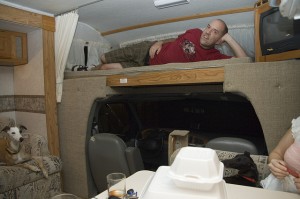
Cozy — some would say “cramped” — quarters come standard in many motor homes. (Jessa B.C., Flickr Creative Commons)
I once ran into a RVing couple, Gary and Linda Powell, who had just established a business that required a lot of face-to-face contact with customers across the country.
Like many other Americans on the go, the Powells kept a small self-storage unit for belongings that wouldn’t fit into the mobile home. Their mail went to “the office” — a spare bedroom in Gary’s sister’s house. The sister gathered it, sorted it, then sent it ahead to the Powells’ next destination.
One summer I crossed the United States in an antique car rally. Several of the days I rode with a group of six neighbors from Texas in a big-old mobile home that they own together.
These folks had their individual duties broken down just so. One was usually the driver. Someone else did the shopping. Another was a great cook. One fellow was a crack mechanic, which can be important should the engine, heating, or plumbing break down. One of the six neighbors drove on ahead in an automobile, looking for road hazards, steep grades, and safe places to park for the night.
Somehow, the motor home slept all six of them.
Like many RV owners, they talked to each other via citizens’-band radios, using “handles,” or nicknames, such as “Motorin’ Mama” and “the Texas Troubadour,” just like truckers. The Texan who drove on ahead of his friends, for instance, was “Kit Carson.” Carson was a legendary Wild West scout.
While motor-home drivers and passengers alike are supposed to keep their seat belts fastened, it’s not uncommon to find someone in back reaching for cold refreshments, spreading maps out on a table — even taking a nap on the couch that folds out into a somewhat comfy bed.
There was a time, back in the 1930s, when “motor homes” did not have “all the comforts of home.” They were little more than crude, converted buses whose owners had few safe campgrounds — equipped with electricity, showers, and even swimming pools — to choose from, the way RV owners can today. I remember a hilarious “I Love Lucy” episode on television in which Lucy, her husband, and two friends crossed the country scrunched into a tiny trailer that looked like a toaster on wheels.
It was in the ’30s — the era of streamliner trains, planes, and automobiles — that a travel trailer with a shiny aluminum skin made its debut. Its very name — Airstream — suggested smooth, aerodynamic travel. The riveted-aluminum shell of the first “Airstream Clipper” in 1936 borrowed the burnished look of the new Pan Am Clipper airplane and of streamlined steamships and railroad locomotives. “Silver bullets,” some people called them. Their polished shell was so light that two workers could easily lift it onto its bed. The utilitarian interior, though, resembled a cramped boat cabin.
Many people who bought into the mystique of these stylish little trailers loved to show them off so much, they towed them by the hundreds in caravans around the globe. The Airstream Co. founder, Wally Byum, was one of them. He preached what he called Airstream’s “Four Freedoms”:
• Freedom from arrangements. No need for hotel reservations.
• Freedom from the problems of age. Especially boredom.
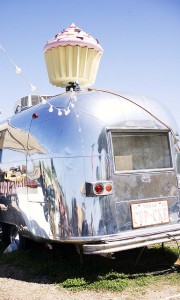
Airstreams and motor homes are often put to “adaptive reuse.” This one is now the home of a cupcake-sales operation. (B*2, Flickr Creative Commons)
• Freedom to know. On a train or plane, you meet someone interesting and go your own way. Traveling by trailer, you meet people in their homes-on-wheels, and they meet you in theirs.
• Freedom for fun. That one’s self-explanatory.
Airstreams are still being made, and today the company offers far fancier options than existed when these trailers first headed out across the landscape 70-some years ago.
Each year, when thousands of trailer and motor-home owners attend rallies in various U.S. cities, they often pull their RVs into a circle, as trains of horse-drawn covered wagons used to do on the American prairie in the nineteenth century. Within the central hub, they have coffee and “grub” — or the evening meal — over a campfire.
And a lot of them don’t give a thought to what’s going on back home, since, wherever they go, they are at home.
Ted's Wild Words
These are a few words from this posting that you may not know. Each time, I'll tell you a little about them and also place them into a cumulative archive of "Ted's Wild Words" in the right-hand column of the home page. Just click on it there, and if there's another word that you'd like me to explain, just ask!
McMansion. A supersized house, out of proportion to others on the block.
Oxymoron. A combination of contradictory terms. “Light opera,” for instance, might be one of them.
Vagabond. Someone with no fixed home who’s always on the go. A nomad.

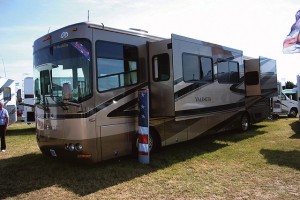
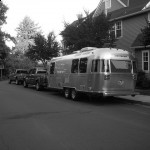

One response to “Couch Potatoes on Parade!”
it was very interesting, thank you . I like your blogs, so I can learn american language and life with pleasure. G.C.